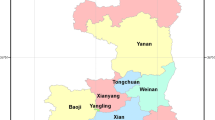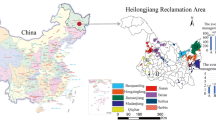Abstract
A Projection Pursuit Evaluation model of surface water environment based on an Improved Chicken Swarm Optimization Algorithm (ICSOA-PPE) is constructed using the ICSOA to optimize the optimal projection direction. Using the Jiansanjiang Administration in Heilongjiang Province, China as an example, 15 subordinate farms were used as an evaluation unit by selecting water quality indexes including CODMn, NH3-N, TP, TN, F− to evaluate the environmental quality of surface water using the ICSOA-PPE model. The results show that the environmental quality of surface water from all farms in this region was generally poor, except for that at the Qinglongshan, Qindeli and Daxing farms. These three farms met the standard for drinking water sources, while the remaining farms failed to reach the standard. By analyzing the relationship between the total amount of chemical fertilizer application per ha, the amount of nitrogen fertilizer application per ha, the amount of phosphate fertilizer application per ha and the environmental quality of the surface water, a conclusion could be reached that the total amount of chemical fertilizer has a substantial effect on water environment. Additionally, the contribution rate of the amount of nitrogen fertilizer application per ha to the organic pollution and the concentration of NH3-N is substantial, and the amount of phosphate fertilizer influences the water environmental quality to some extent. An analysis and comparison of the traversal capacity, the offset capacity and the convergence capacity of the Genetic Algorithm (GA), the Chicken Swarm Optimization Algorithm (CSOA) and ICSOA reveal that ICSOA is the better optimization algorithm, indicating that the ICSOA-PPE model is logical and reliable.






Similar content being viewed by others
References
Aryafar A, Gholami R, Rooki R, Doulati Ardejani F (2012) Heavy metal pollution assessment using support vector machine in the Shur River, Sarcheshmeh copper mine, Iran. Environ Earth Sci 67(4):1191–1199. https://doi.org/10.1007/s12665-012-1565-7
Bachmann CM, Musman SA, Luong D, Schultz A (1994) Unsupervised BCM projection pursuit algorithms for classification of simulated radar presentations. Neural Netw 7(4):709–728. https://doi.org/10.1016/0893-6080(94)90047-7
Berro A, Larabi Marie-Sainte S, Ruiz-Gazen A (2010) Genetic algorithms and particle swarm optimization for exploratory projection pursuit. Ann Math Artif Intell 60(1-2):153–178. https://doi.org/10.1007/s10472- 010-9211-0
Chen XH (2001) Water environment assessment and planning. SUN Yat-sen University Press, Guangzhou
Chen J, Zhu JM, Wang ZY, Liu XH, Zhang XL (2007) Application of Grey relational analysis in water quality evaluation. J Grey Syst 19(1):99–106
Chen GZ, Wang JQ, Li CJ (2008) Solving the optimization of projection pursuit model using improved ant Colony algorithm. In: Fourth International Conference on Natural Computation pp 521–525. doi: https://doi.org/10.1109/ICNC.2008.582
Dahiya S, Singh B, Gaur S, Garg VK, Kushwaha HS (2007) Analysis of groundwater quality using fuzzy synthetic evaluation. J Hazard Mater 147(3):938–946. https://doi.org/10.1016/j.jhazmat.2007.01.119
Demirci O, Clark VP, Calhoun VD (2008) A projection pursuit algorithm to classify individuals using fMRI data: application to schizophrenia. NeuroImage 39(4):1774–1782. https://doi.org/10.1016/j.neuroimage.2007.10.012
Deng XJ, YP X, Han LF, ZH Y, Yang MN, Pan GB (2015) Assessment of river health based on an improved entropy-based fuzzy matter-element model in the Taihu plain, China. Ecol Indic 57:85–95. https://doi.org/10.1016/j.ecolind.2015.04.020
Espezua S, Villanueva E, Maciel CD (2014) Towards an efficient genetic algorithm optimizer for sequential projection pursuit. Neurocomputing 123:40–48. https://doi.org/10.1016/j. neucom.2012.09.045
Friedman JH, Tukey JW (1974) A projection pursuit algorithm for exploratory data analysis. IEEE Trans Comput 23(9):881–890. https://doi.org/10.1109/T- C.1974.224051
Fu Q, Xie YG, Wei ZM (2003) Application of projection pursuit evaluation model based on real-coded accelerating genetic algorithm in evaluating wetland soil quality variations in the Sanjiang plain, China. Pedosphere 13(3):249–256
Ghasemi JB, Zolfonoun E (2013) Simultaneous spectrophotometric determination of trace amount of polycyclic aromatic hydrocarbons in water samples after magnetic solid-phase extraction by using projection pursuit regression. Environ Monit Assess 185(3):2297–2305. https://doi.org/10.1007/s10661-012-2709-7
Gong YC, Zhang Y, Ding F, Hao J, Wang H, Zhang D (2015) Projection pursuit model for assessment of groundwater quality based on firefly algorithm. J China Univ Min Technol 44(3):566–572
Gupta R, Majumdar A (2014) Reconsidering the welfare cost of inflation in the US: a nonparametric estimation of the nonlinear long-run money-demand equation using projection pursuit regressions. Empir Econ 46(4):1221–1240. https://doi.org/10.1007/s00181-013 -0721-6
Hafez AI, Zawbaa HM, Emary E, Mahmoud HA (2015) An innovative approach for feature selection based on chicken swarm optimization. In: international conference on soft computing and pattern recognition, IEEE. Vol 2. Pp 269-279
Haque MM, Al Attas HA, Hassan MA (2016) Health risk assessment of trace elements in drinking water from Najran City, southwestern Saudi Arabia. Arab J Geosci 9(6):1–12. https://doi.org/10.1007/ s12517-016-2501-z
Ji XL, Dahlgren RA, Zhang M (2016) Comparison of seven water quality assessment methods for the characterization and management of highly impaired river systems. Environ Monit Assess 188(1):1–16
Jiang T, Jia HJ, Yuan HY, Zhou N (2015) Projection pursuit: a general methodology of wide-area coherency detection in bulk power grid. IEEE Trans Power Syst 31(4):1–11
Khaki M, Yusoff I, Islami N (2015) Application of the artificial neural network and neuro-fuzzy system for assessment of groundwater quality. CLEAN – Soil, Air, Water 43(4):551–560. https://doi.org/10.1002/clen.201400267
Li RZ (2005) Progress and trend analysis of theoretical methodology of water quality assessment. J Hefei Univ Technol 28(4):369–373
Liu D, Hu YX, Fu Q, Imran KM (2016) Optimizing channel cross-section based on cat swarm optimization. Water Sci Technol Water Supply 16(1):219–228. https://doi.org/10.2166/ws.2015.128
Lv P, Liu D, Zhao FF (2011) Comprehensive evaluation of water resources carrying capacity in Jiansanjiang branch bureau. Adv Mater Res 204-210:834–837. https://doi.org/10.4028/www.scientific.net/AMR.204-210.834
Ma Y, Zhao YX, LG W, He YX, Yang XS (2015) Navigability analysis of magnetic map with projecting pursuit-based selection method by using firefly algorithm. Neurocomputing 159(1):288–297. https://doi.org/10.1016/j.neucom.2015. 01.028
Meng X, Liu Y, Gao X, Zhang H (2014) A new bio-inspired algorithm: chicken swarm optimization. In: Tan Y, Shi YH, Coello CAC (eds) Advances in swarm intelligence: 5th international conference, ICSI 2014, Hefei, China, October 17–20, 2014, proceedings. Part I. Springer International Publishing, Cham, pp 86–94. https://doi.org/10.1007/978-3-319-11857- 4_10
Nganje TN, Hursthouse AS, Edet A, Stirling D, Adamu CI (2015) Assessment of the health risk, aesthetic and agricultural quality of rainwater, surface water and groundwater in the shale bedrock areas, southeastern Nigeria. Water Qual Expo Health 7(2):153–178. https://doi.org/10.1007/ s12403-014-0136-4
Pei W, Fu Q, Liu D, Li TX, Cheng K (2016) Assessing agricultural drought vulnerability in the Sanjiang plain based on an improved projection pursuit model. Nat Hazards 82(1):683–701. https://doi.org/10.1007/ s11069-016-2213-4
Sarkar A, Vulimiri A, Paul S, Iqbal J, Banerjee A, Chatterjee R, Ray SS (2012) Unsupervised and supervised classification of hyperspectral imaging data using projection pursuit and Markov random field segmentation. Int J Remote Sens 33(18):5799–5818. https://doi.org/10.1080/ 01431161.2012.670959
Shao L, Zhou XD, Yang FT, Han J (2010) Projection pursuit model for comprehensive evaluation of water quality based on free search. China Environ Sci 30(12):1708–1714
Tao L, Cai SM, Yang HD, Wang XL, SJ W, Ren XY (2009) Fuzzy comprehensive-quantifying assessment in analysis of water quality: a case study in Lake Honghu, China. Environ Eng Sci 26(2):451–458. https://doi.org/10.1089/ees.2007.0270
Wang SJ, Yang ZF, Ding J (2004) Projection pursuit cluster model and its application in water quality assessment. J Environ Sci 16(6):994–995
Wu, DH Kong F, Gao WZ, Shen YX (2015) Improved chicken swarm optimization. In: The 5th Annual IEEE International Conference on Cyber Technology in Automation, Control and Intelligent Systems pp 681–686. doi: https://doi.org/10.1109/CYBER.2015.7288023
Xiong P, Lou WG (2016) Determination and analysis of reasonable value of key parameter in projection pursuit clustering modelling. Comput Eng Appl 52(9):50–55
Zheng Y, Han F (2016) Markov chain Monte Carlo (MCMC) uncertainty analysis for watershed water quality modeling and management. Stoch Env Res Risk A 30(1):293–308. https://doi.org/10.1007/ s00477-015-1091-8
Acknowledgements
This study is supported by the National Natural Science Foundation of China (No.51579044, No.41071053, No.51479032), National Key R&D Program of China (No.2017YFC0406002), Natural Science Foundation of Heilongjiang Province (No.E2017007), Science and Technology Program of Water Conservancy of Heilongjiang Province (No.201319, No.201501, No.201503).
Novelty
-
1.
An composite evaluation model of surface water environment named ICSOA-PPE is proposed.
-
2.
Compared with NIM and GRAM, the ICSOA-PPE model can objectively reflect the water environmental quality.
-
3.
ICSOA is superior to GA and CSOA in traversal capacity, offset capacity and convergence capacity, and it can obtain a better global optimum.
-
4.
The spatial variation characteristic of surface water environment and the possible causes are analyzed.
Author information
Authors and Affiliations
Corresponding author
Rights and permissions
About this article
Cite this article
Liu, D., Liu, C., Fu, Q. et al. Projection Pursuit Evaluation Model of Regional Surface Water Environment Based on Improved Chicken Swarm Optimization Algorithm. Water Resour Manage 32, 1325–1342 (2018). https://doi.org/10.1007/s11269-017-1872-6
Received:
Accepted:
Published:
Issue Date:
DOI: https://doi.org/10.1007/s11269-017-1872-6




